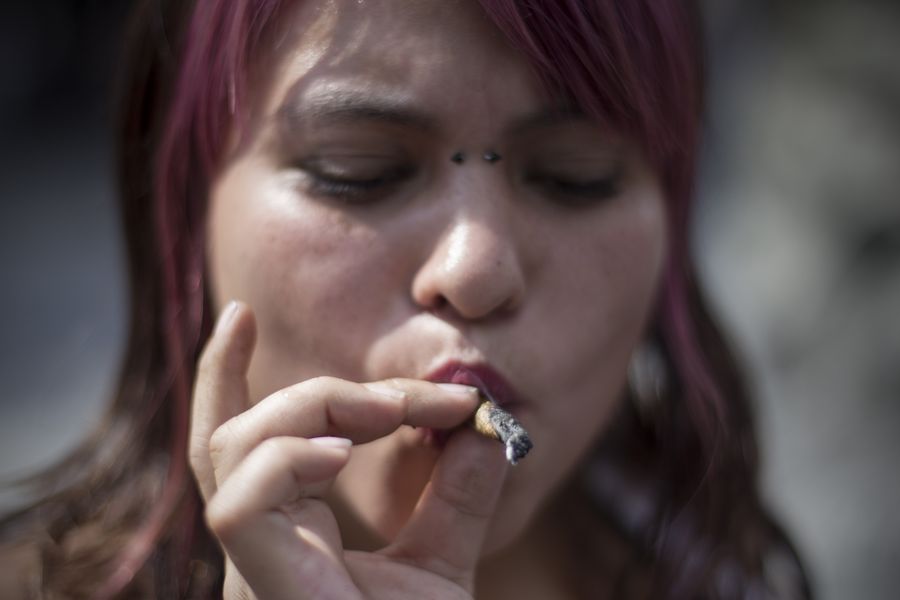
A woman smokes marijuana during a demonstration in front of the National Supreme Court of Justice in Mexico City, capital of Mexico, on Nov. 4, 2015. (Xinhua/Alejandro Ayala)
One possible reason behind the continuing increase in marijuana use among college students and non-college youth is the ongoing decline in perceptions of risk of harm from regular marijuana use.
CHICAGO, Sept. 5 (Xinhua) -- U.S. college students' use of marijuana in 2018 was at the highest level seen in the past 35 years, according to the annual national Monitoring the Future Panel study posted on the website of the University of Michigan (UM) on Thursday.
Moreover, vaping of marijuana and of nicotine each doubled for college students between 2017 and 2018.
The study shows that in 2018, 43 percent of full-time college students aged 19-22 reported using marijuana at least once in the prior 12 months. The five-year trend, from 2013 to 2018, increased a statistically significant 7 percentage points. Twenty-five percent reported using at least once in the prior 30 days, showing a significant increase over the past five years. Both of these prevalence levels are at historic highs since 1983, when they were 45 percent and 26 percent, respectively.
Same-age high school graduates who are not full-time college students show a similar upward trend over time. In 2018, their annual prevalence was 43 percent and 30-day prevalence was 27 percent, the highest levels since the 1980s.
Thirty-day prevalence of vaping marijuana also increased for college students from 5.2 percent in 2017 to 10.9 percent in 2018, a significant 5.7 percentage point increase. Among non-college respondents, 30-day prevalence level was at 8 percent in 2017 and 2018.
Daily or near daily use of marijuana, defined as having used on 20 or more occasions in the prior 30 days, was at 5.8 percent in 2018 for college students. It has been between 4 percent and 6 percent in the past five years. Among same-age non-college youth, it was 11.1 percent, nearly double the level for college youth. The gap between college and non-college youth has widened in recent years.
The researchers attributed the continuing increase in marijuana use among college students and non-college youth to multiple reasons. And one possible reason is the ongoing decline in perceptions of risk of harm from regular marijuana use. In 2018, 22 percent of those aged 19-22 perceived regular use of marijuana as carrying great risk of harm, a significant 5 percentage point decline from 2017, and the lowest level since 1980 when tracking of this age group began.
Vaping nicotine also showed dramatic increases for college students, with 30-day prevalence rising a significant 9.4 percentage points from 6.1 percent in 2017 to 15.5 percent in 2018, which again is one of the largest one-year proportional increases for any substance over the past 40 years. It increased non-significantly for non-college respondents, from 7.9 percent in 2017 to 12.5 percent in 2018.
The annual study also examined the use of other illicit drugs, alcohol, and tobacco. The study results show that annual use of any of the illicit drugs other than marijuana was 18 percent in 2018 for both college and non-college youth, declining somewhat for both groups since recent highs in 2014; annual cocaine use increased significantly over the past five years, from 2.7 percent in 2013 to 5.2 percent in 2018, the highest it has been over the past decade; alcohol use has been declining for several years among college students, and binge drinking, defined as having five or more drinks in a row at least once in the past two weeks, significantly declined for college students to 28 percent in 2018, a record low since 1980; and 30-day cigarette smoking among college students was 6.8 percent in 2018, a record low since 1980.
Conducted by a team of UM research professors, the annual national Monitoring the Future Panel Study has been tracking substance use among American college students and non-college youth since 1980. The results are based on data from college students one to four years beyond high school graduation enrolled full-time in a two- or four-year college in March of the given year, compared with same-age high school graduates not enrolled full-time in college.



